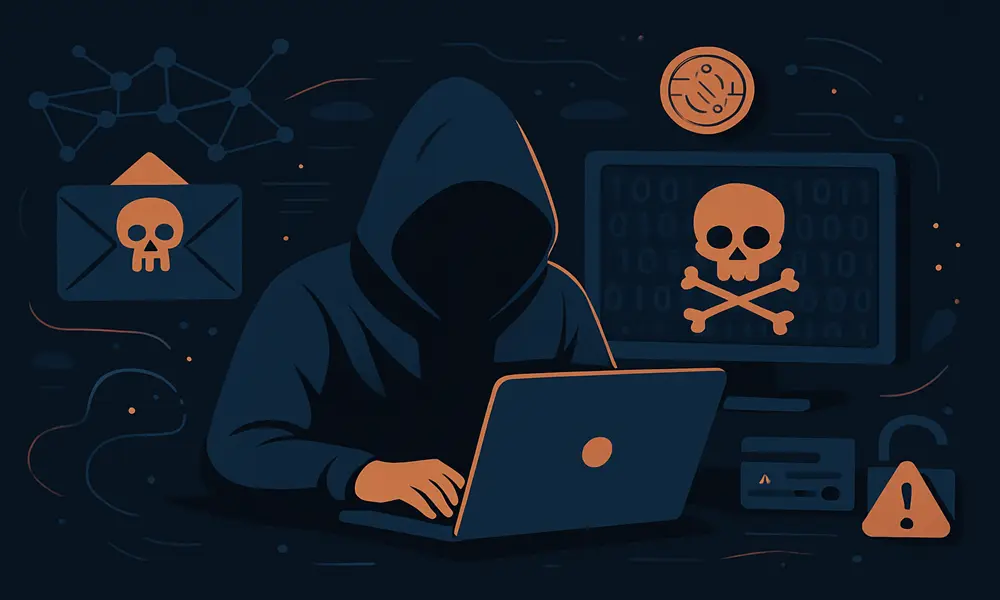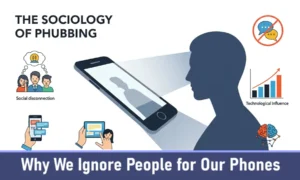The Rise of Cybercrime in the Digital Era: Emerging Cyber Threats and Essential Prevention Tips
Cybercrime has surged in the digital era, evolving alongside technological advancements. As businesses, governments, and individuals rely more on digital infrastructure, cybercriminals exploit vulnerabilities for financial gain, espionage, and disruption.
Cybercrime is escalating at an unprecedented pace, with global costs projected to reach $9.5 trillion in 2024 and $10.5 trillion by 2025 — figures that eclipse the GDP of most nations and exceed damages from natural disasters.
The average cost of a single data breach climbed to $4.88 million in 2024, marking the highest level ever recorded. Breaches involving malicious insiders averaged $4.99 million, making them the most expensive attack vector.
Let’s understand the rise of cybercrime in the digital age, explore emerging cyber threats, and follow essential prevention tips to stay safe online.

Introduction: The Growing Danger of Cybercrime in the Digital Age
The digital age has revolutionized global connectivity, linking people and businesses through devices, applications, and online services.
Whether through cloud computing, IoT, or AI-driven platforms, seamless communication and collaboration transcend borders. This connectivity delivers tremendous benefits, but also opens pathways for criminals. Cybercrime now represents the third-largest “economy” in the world when measured by cost.
Every day, new tools and methods emerge that help attackers bypass defenses. From AI-generated phishing to quantum-era threats, the landscape is shifting rapidly. At the same time, defenders have more resources than ever — but they must act wisely and proactively.
In this article, we will explore 9 new cybercrime threats in the digital age and share some effective cybercrime prevention tips you can use right now. Each threat and tip is explained simply, so you can understand and apply these strategies without needing a technical background.
Cybercrime Evolution: 9 Emerging Cyber Threats Reshaping Online Security
Cybercrime has evolved dramatically over the decades, adapting to technological advancements and security measures.
Early cyber threats in the 1970s and 1980s focused on phone phreaking and basic computer worms. By the 1990s, the rise of the internet introduced email scams, viruses, and hacking. The 2000s saw the emergence of ransomware, phishing, and large-scale data breaches.
Today, cybercrime is evolving rapidly, with new threats reshaping online security. Cybercriminals leverage AI, deepfakes, quantum computing risks and more, making cybersecurity more critical than ever. Here are some emerging cyber threats to watch out for:
1. AI-Powered Phishing Campaigns
AI-powered phishing campaigns leverage generative AI to craft highly convincing emails, mimicking executives or company domains with perfect grammar and style.
Unlike traditional scams, these emails adapt dynamically, using context-aware messaging to evade spam filters.
Attackers trick recipients into sharing passwords or clicking malicious links, leading to data breaches or financial losses.
As AI-driven phishing grows more sophisticated, businesses must strengthen email authentication, cybersecurity training, and AI-powered threat detection to stay ahead of evolving scams.
2. Deepfake Scams
Deepfake scams leverage AI to create highly realistic fake videos or audio, often impersonating public figures or colleagues.
Criminals use these to trick victims—like sending a fabricated CEO recording requesting urgent payments or confidential data.
Since deepfakes look and sound incredibly real, skepticism drops, increasing success rates.
Deepfake scams pose huge security risks, making verification protocols, biometric authentication, and AI-driven detection tools crucial for preventing fraud.
3. Ransomware & Multifaceted Extortion
Ransomware attacks have evolved into multifaceted extortion, going beyond simple file encryption. Some attackers use double or triple extortion, pressuring victims with legal, financial, or reputational damage. These tactics make ransomware more damaging and lucrative than ever.
Ransomware-as-a-Service (RaaS) makes cybercrime accessible to even unskilled hackers, allowing them to launch ransomware attacks with ease.
Operators provide ready-made ransomware kits, encryption tools, payment processing, and even customer support, taking a cut of ransom payments in return. This business model has fueled a rise in large-scale cyberattacks on hospitals, infrastructure, and corporations.
As RaaS networks grow, cybersecurity measures must evolve to combat the increasing frequency and sophistication of these threats.
4. Supply Chain Attacks
Supply chain attacks exploit vulnerabilities in third-party vendors, allowing cybercriminals to inject malware into software updates or services used by thousands of organizations.
By compromising a single provider, attackers gain widespread access, spreading malicious code like a Trojan horse.
High-profile cases include attacks on software build pipelines and managed service providers, leading to data breaches, ransomware incidents, and operational disruptions.
Strengthening vendor security, code integrity, and real-time monitoring is crucial to preventing such threats.
5. Cloud Intrusions
As businesses move critical workloads to the cloud, attackers follow and cybercriminals are adapting their tactics.
In 2024, cloud intrusions surged, with attackers exploiting misconfigured storage buckets, credential theft, and API vulnerabilities to gain unauthorized access.
Once inside, these intrusions can exfiltrate sensitive data, install persistent backdoors, or launch lateral attacks across corporate networks.
As cloud adoption grows, strengthening access controls, encryption, and real-time threat monitoring is essential to prevent breaches and safeguard digital assets.
6. Fileless and Malware-Free Attacks
Fileless attacks bypass traditional antivirus defenses by executing malicious code directly in memory, leaving no detectable files behind.
Hackers exploit legitimate system tools like PowerShell or WMI to move laterally, blending into normal operations—this tactic is known as “living off the land.”
Since signature-based detection struggles to identify these threats, organizations must adopt behavioral analytics and endpoint detection to uncover suspicious activities before attackers gain control.
7. Quantum Computing Threats
Quantum computing poses a serious threat to traditional encryption, with algorithms like RSA and ECC at risk of being cracked within years.
While large-scale quantum decryption remains difficult, “harvest now, decrypt later” attacks are rising. Cybercriminals are already harvesting encrypted data to decrypt later.
Organizations must prepare for post-quantum cryptography, adopting quantum-safe encryption methods to ensure long-term security.
The race is on to stay ahead of this transformative technology before quantum computers reshape cybersecurity.
8. Web3 & Crypto Heists
Cybercriminals are exploiting vulnerabilities in Web3 platforms, including decentralized finance (DeFi) protocols and blockchain networks, to steal digital assets.
These heists often involve smart contract exploits, phishing attacks, or private key theft, leading to major financial losses. As Web3 adoption grows, hackers refine tactics to breach security measures.
Cryptojacking malware stealthily uses victim devices to mine cryptocurrencies. Infected machines slow down, and energy costs rise. Attacks have grown alongside DeFi popularity and easy-to-use mining scripts.
9. Nation-State Cyber Espionage
Nation-state cyber espionage involves governments using advanced cyber tactics to infiltrate rival nations’ systems.
These attacks target critical infrastructure, including power grids, financial networks, and defense systems, aiming to steal intelligence or disrupt operations. Cyber warfare tactics include hacking, misinformation campaigns, and surveillance.
With increasing global tensions, cyber espionage is evolving, making strong cybersecurity measures essential to protect national security and sensitive data from malicious actors.
The Importance of Addressing Cybercrime in Contemporary Society
Addressing cybercrime is crucial because its global economic impact now rivals major world economies, while its social and national security repercussions grow in severity.
In 2024, cybercrime losses are projected to hit $9.5 trillion worldwide, with annual growth of 15 percent expected through 2025, making it the third-largest “economy” after the U.S. and China.
Data breaches averaged $4.88 million per incident in 2024, an all-time high that strains organizational resources and erodes consumer trust.
High-profile operations like Interpol’s recent arrest of over 1,000 suspects illustrate that coordinated law-enforcement efforts are vital to curb increasingly sophisticated threats.
Beyond direct costs, cybercrime undermines critical infrastructure, jeopardizes personal privacy, and can even influence elections, making proactive prevention and international cooperation indispensable.
Cybercrime’s financial toll extends far beyond immediate losses. In the U.S. alone, reported cybercrime losses reached $16.6 billion in 2024, up 9 percent year-over-year, with ransomware and fraud leading the way.
Globally, losses are set to exceed $10.5 trillion by 2025, a figure larger than the annual damage from all natural disasters combined. Such staggering costs divert investment from innovation and inflate cybersecurity insurance premiums, ultimately slowing economic growth.
Victims of cybercrime face more than financial loss. Identity theft and fraud can ruin personal credit and psychological well-being; one in three data breaches exposed “shadow data,” making recovery and monitoring efforts nearly impossible.
Phishing and tech-support scams disproportionately impact the elderly, who filed the most complaints last year, highlighting the need for accessible public education.
The erosion of trust in digital services hampers adoption of beneficial technologies like telehealth and e-commerce.
Malicious actors increasingly target power grids, water treatment facilities, and healthcare systems.
Ransomware attacks against critical infrastructure rose by 9 percent in 2024, threatening public safety and emergency response capabilities.
State-sponsored cyber operations and the risk of “harvest now, decrypt later” strategies further elevate urgency; unpatched data may be stolen today and decrypted when quantum computing matures. Protecting these assets is as vital as defending against physical attacks.
Effective cybercrime mitigation demands robust laws, international cooperation, and public–private partnerships.
Interpol’s Operation Serengeti in Africa demonstrated that coordinated enforcement can yield rapid results, with over 1,000 arrests and $193 million in disrupted fraud.
Meanwhile, the United Nations is negotiating a global cybercrime treaty to standardize definitions and streamline cross-border investigations.
Investing in secure infrastructure, mandatory breach reporting, and cybersecurity education will build resilience and public confidence.
Essential Cybercrime Prevention Tips to Stay Safe Online
The digital world is expanding rapidly, but with that growth comes rising cyber threats. Cybercriminals are constantly evolving their tactics, making it more crucial than ever to stay informed and protected.
Here are essential cybercrime prevention tips to safeguard your online presence:
Enable Multi-Factor Authentication (MFA): MFA adds an extra verification step beyond passwords. It prevents attackers from accessing accounts even if passwords are stolen. Use authenticator apps or hardware keys rather than SMS OTPs when possible.
Keep Software and Systems Updated: Software updates often include security patches for known vulnerabilities. Enable automatic updates where feasible to close gaps quickly. Outdated systems remain a top target for attackers.
Use Strong, Unique Passwords: Weak or reused passwords make credential stuffing simple. A password manager can generate and store complex passwords for every account. Change default credentials on new devices immediately.
Recognize and Avoid Phishing Scams: Phishing remains one of the most effective cybercrime tactics. Always verify sender addresses, look out for misspellings, and avoid clicking suspicious links. If uncertain, contact the organization directly through official channels.
Perform Regular Data Backups: Back up critical data offline or to an isolated cloud. Test your backups regularly to ensure you can restore quickly after an incident. This reduces the impact of ransomware and data loss events.
Educate and Train Employees: Human error remains a leading cause of breaches. Hold frequent security awareness sessions on spotting phishing and social engineering. Simulated phishing exercises help reinforce best practices.
Adopt a Zero-Trust Architecture: Zero trust means verifying every user and device before granting access. Implement micro-segmentation and least-privilege access controls. This limits the blast radius of a compromised account.
Develop and Test an Incident Response Plan: A clear, practiced plan speeds detection and recovery. Define roles, communication paths, and escalation procedures in advance. Run tabletop exercises to identify gaps and improve response times.
Implement Network Segmentation and Access Controls: Divide your network into secure zones to contain breaches. Critical assets should only be reachable by authorized systems and users. Use firewalls, VLANs, and access control lists to enforce segmentation.
Limit Personal Information Sharing: Avoid oversharing personal details on social media, such as birthdates, addresses, or financial information. Be cautious when engaging with unknown individuals or websites requesting sensitive data.
Use VPNs on Public Wi-Fi Networks: Public Wi-Fi can expose data to eavesdropping and man-in-the-middle attacks. A reputable VPN (Virtual Private Network) encrypts your traffic on untrusted networks. Ensure your VPN uses strong protocols like WireGuard or OpenVPN.
Monitor Your Online Accounts Regularly: Cybercriminals may attempt unauthorized access without immediate detection. Check your online accounts regularly for unusual login activity, fraudulent transactions, or security alerts. Set up account notifications to be instantly informed of suspicious login attempts.
Read Here: What are the Top 10 Best Antivirus Software to Use?
Conclusion: New Cyber Threats in a Digital World
The digital world faces ever-evolving cyber threats, with attackers leveraging AI, automation, and sophisticated techniques to bypass defenses.
AI-powered phishing creates hyper-realistic scams, deepfake fraud manipulates victims, and ransomware-as-a-service makes cybercrime accessible to all.
Quantum computing risks threaten traditional encryption, while fileless malware evades detection by running in memory.
Cloud intrusions, supply chain attacks, Web3 exploits, and IoT vulnerabilities expose businesses to large-scale breaches.
Cybercrime is a fast-moving threat that demands vigilance. Costs continue to climb into the trillions, and breaches now average nearly $5 million per incident.
If you understand the emerging cyber threats, you can better anticipate attackers’ next moves.
Businesses must adopt advanced cybersecurity measures to combat these emerging digital threats effectively. Adopting the prevention tips outlined above will greatly reduce your risk.
Whether you are an individual user or part of a large enterprise, simple measures like enabling MFA and keeping software updated make a big difference.
Staying secure in the digital age is an ongoing process. Commit to regular training, planning, and review.
With the right mindset and tools, you can turn the tide against cybercrime and protect what matters most.
Read Here: How Digital media Shapes Public Views on Crime and Deviance
Author: Mahtab Alam Quddusi – A Passionate Writer, Social Activist, Postgraduate in Sociology and Social sciences and Editor of ScientificWorldInfo.Com





